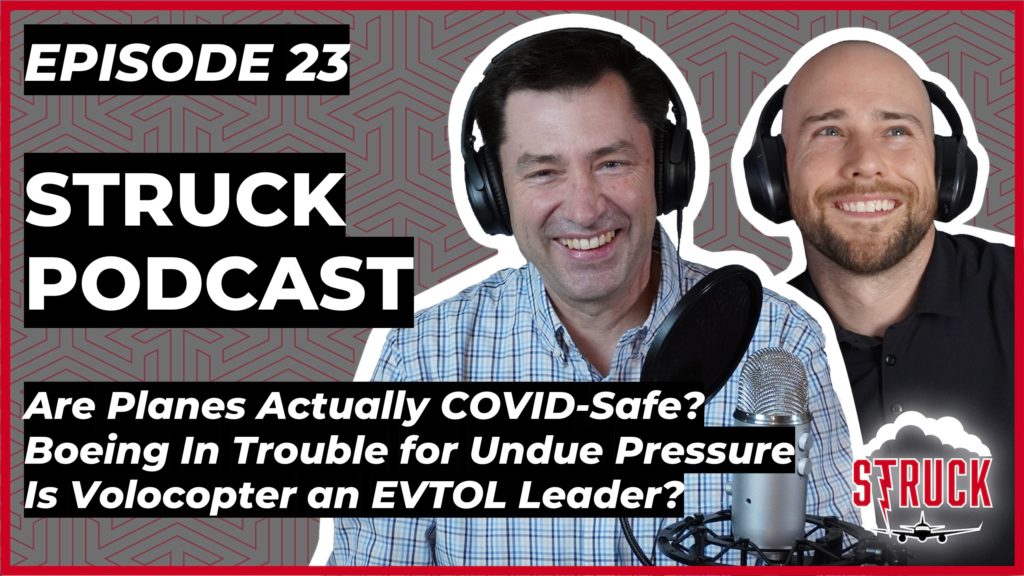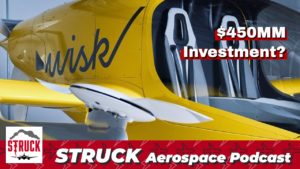In this episode, we discuss the odds of catching COVID-19 on a flight, as explained in an interesting new article that explores proximity to other passengers and more. Boeing may be fined $1.25 million in a clear-cut case of undue pressure applied to engineers in their South Carolina plant. And, Allen likes the Volocopter EVTOL design – is it a future winner in the market?
Learn more about Weather Guard StrikeTape segmented lightning diverter strips. Follow the show on YouTube, Twitter, Linkedin and visit us on the web. Have a question we can answer on the show? Email us!
Podcast: Play in new window | Download
Transcript: Struck Podcast EP23 – Odds of Catching COVID on a Plane? Boeing In Trouble for Undue Pressure, Plus: Is Volocopter an EVTOL Leader?
Dan: This episode is brought to you by Weather Guard Lightning Tech. At Weather Guard we support design engineers and make lightning protection easy.
You’re listening to the Struck Podcast. I’m Dan Blewett
Allen: I’m Allen hall.
Dan: And here on struck, we talk about everything. Aviation, aerospace engineering, and lightning protection.
All right. Welcome back. This is the Struck podcast episode 23, I’m your cohost, Dan Blewett. And in today’s episode, we’ve got a lot of good stuff to cover first interesting article about the odds of catching COVID-19 on a flight, which uses some, uh, percentages. And this was actually a really interesting read.
Glad we found this article. Um, we’re gonna talk a little bit about the advantages and challenges of electric powered airliners, which are potentially in our future. Maybe allow along with, uh, with hydrogen as well. We know all these, all these technologies are being explored by all these major companies and our engineering segment.
We’re going to talk about Boeing in trouble, again, with a undue pressure that they’ve been applying to some safety reps out of their South Carolina, uh, factory. And. Man, that’s been an ongoing thing. We’ve talked about that before and here we are again, and we’re also going to chat a little bit about vertical airspace and Honeywell.
They’re doing some interesting stuff together. And lastly, in our electric texts segment, we’re going to talk about Vola copter, which. Yeah, Alan, there you are. How are you, sir? You are very outspoken about these designs. And this one in my view is like the most, it looks like a toy plastic helicopter of all of them, but you’re digging it.
So why?
Allen: Yeah, I think it’s cool. I think it’s cool. A bit of flying a human in it. So that puts him ahead of everybody else on my scale.
Dan: Yeah. Well, your proof’s in the pudding, I guess so. Well, let’s, let’s talk about this before we get there later, let’s talk about the odds of catching covert in a flight. And so.
Planes are flying an increasing amount. Obviously it’s still knower like normal, but we’re getting back there. And so far it doesn’t seem like these are the, these are the vehicles of, of infection. Like, it doesn’t seem like there’s mass spread coming from airliners. And they’re talking about in this article, I’m at a Bloomberg, which is really interesting.
Uh, just about the odds of getting it. You know, the, basically this a researcher, mr. Barnett is talking about that you have a base sale, one in 4,300 chance of getting COVID-19 on a full two hour flight. Um, so yeah. What, what, what were your takeaways from this article?
Allen: Well, that’s the, that, that number is based upon just the, having somebody sitting next to you with a, uh, sitting extra for two hours and everybody’s mast, obviously.
So there’s, uh, you know, the percentages kind of change depending on where you are in the aircraft rights. So. That’s why the probabilities are so low that unless you’re really sitting real close to that particular person. And there’s some, some probabilities with that. I, it seems like the there’s enough flight data and enough tracing history right now that there’s, I think you could.
Pretty well say there’s not huge outbreaks. I think the cruise ships have had significant outbreaks of 20% of the, of the population on a particular cruise coming positive on an aircraft. We don’t see that. So the one in roughly 5,000 numbers. Not bad.
Dan: One key thing. No, one’s rubbing suntan lotion on each other.
I want a flame.
Allen: I hope not
the flight then. I don’t know
Dan: traveling. I’m sorry. I didn’t mean to cut you off there. I just had to throw that joke in, but, um, But, yeah. So, and then what’s interesting about this article is that he’s talking about look just the proximity to other passengers. So if, if there is one or two people on board that does have it, how close are you to them also?
Uh, so you know, again, tons about the systems on an aircraft and he’s talking about. How the air is constantly being renewed in airplane cabin. So it seems like every 30 minutes, uh, you pretty much brand new air
Allen: sooner than that. Totally sooner than that. Every couple of minutes, but it’s also so about two thirds of the air is getting dumped overboard about a third is getting recycled back into the cabin after it passes through HEPA filters.
Uh, and you know that the airlines are changing those HEPA filters on a regular basis. Plus they’re cleaning the cabin. So there shouldn’t be much going into the HEPA filters to begin with the clog it, because the aircraft are as clean as they probably have ever been. So, you know, the, the, the, the air circulation system is going to be working at roughly peak performance.
You would think right now. So your, your risk goes way, way down and yeah. And adding that middle seat opening, basically adjunct a factor of two. A probability. So it lowers your, your rate by a factor of two that’s. That’s a, that’s a huge, uh, improvement for, uh, a single seat that makes a big deal, but it just gets back into the likelihood that someone really has it when and not to say that people haven’t traveled.
With COVID and not, not know it, but it appears to me having traveled a good bit during this time, at least a couple of times we’ve traveled. There is nobody that appears to be even remotely sick or have symptoms or right. They don’t do any of that. And even if they had seasonal allergies in which we’re in that period of time or seasonalities pop up.
No one at the airport is showing signs of seasonal allergies. They’re just not traveling. So again, I think your risk are hello, compared to other things that people are doing, like going to the grocery store or go into the pharmacy. You got to kind of put it way down on the list of risk items right now.
Dan: Yeah. And you also wonder if the people that are saying, Oh, I feel okay. Traveling are probably living a healthier lifestyle in general. Like maybe exercise a little more. I have no data to back that up, but you probably think that maybe the people who are healthiest or most likely to like give it a go.
Seems reasonable though. I have no data. That’s just a, I
Allen: think I would say that’s in ballpark is probably true. I think that people that feel they would be at risk are not traveling.
Dan: Yeah. Which is good, which is good. Yeah.
Allen: Which is smart. What’s your they’re way? The odds also. So if I, if I was 80 years old, I’m probably knocking on an airplane.
If I had, uh, a weakened immune system, for whatever reason, I’m probably not traveling on an airplane. So you, I think you’re right about that. I think people are making smart decisions about how to travel and so what’s left and that is the traveling public is in pretty good, healthy shape and the right.
Age demographic, where they’re not gonna, uh, have severe consequences if they do happen to pick it up. So I think you’re partially right about that.
Dan: So let let’s shift gears here. So a really good article in aviation week about, uh, propulsion systems. So the advantages and challenges of electric powered airliners.
So. Um, obviously like with Tesla automobiles, one of the cool things about them is that their torque curve is very short and that goes zero to 60 in like basically hyper speed. Right. Um, and that’s one of the one advantage here with electric motors on aircraft as well. But, um, can you talk us through the, kind of the pros and cons.
Allen: Of of just sort of electric propulsion on aircraft. Uh here’s here’s, here’s sort of my delineation of all this. You’ll never get to jet speeds on electric aircraft. That’s not going to happen. So there’s, there’s some sort of misnomer. I think that you can take a seven 37 rip off. It’s a, it’s a kerosene burning jet engines and put on a, uh, electric fan and it’s going to go just as fast wrong.
Totally wrong. Right? It’s some part of the thrust is the burning of fuel is mass times acceleration. Right? So that’s force. So you’re actually burning something, celebrating it. It’s shoving out the backside, which is creating force and thrust. You don’t have that with electric propulsion. So, what you’re talking about now is turbo props, uh, Q 400 dash eight, uh, King air ATR 72.
I’m just rattling off on turboprop airplanes. That’s the kind of thing you’re talking about replacing. So you’re talking about a 200. Plus mile an hour kind of aircraft that, or a short three 60 there’s another one we had in Belfast. There’s us. There’s a bunch of them that you’re just going to replace those aircraft, which don’t tend to be along there.
Those are of four or five hours are gonna fly an hour. Maybe too, because the noise to kids to get you. So that’s the market they’re replacing that’s I think that’s the only market they can possibly replace it. And this is why the European consortium’s are focused on hydrogen because propellers are not the future for, for flights across the Atlantic.
Just,
Dan: yeah.
Allen: Yeah. You know, Well, we had the Concord back in the seventies and I think if anything, so it’s like reliving, like with Elon Musk’s, uh, uh, space launch, the astronauts coming back the other day, you know, we’re kind of reliving the late 1960 until the 1970s. I feel like we’re kind of getting back to that a kid on terms of a flight, or we’re starting to push supersonic aircraft in the commercial sense.
I don’t, that’s not going away. To get from New York to London in an hour is still desirable. It just isn’t people will pay for it. People will pay for it. So our six hour flight from New York to London on a seven, six, seven, whatever it is, it’s not going to turn into a 14 hour flight where you have a stop in Greenland.
That ain’t happening on a turboprop, not today
Dan: now. Um, one thing mentioned the article is that electric drive trains can be more than 90% efficient compared with 55% for large turbofans and 35% for small turbo props. Um, is there any way to, I mean, obviously that’s a pretty impressive number, but like you said, The noise is just going to be a drowning out factor.
I mean, can you put them on the rear, make it like pusher planes, or some kind of unique, um, you know, design that can maybe alleviate some of that noise pain?
Allen: Well, the NASA did a bunch of experiments back in the 1980s and nineties on a sort of ducted fans and kind of rotating propellers, uh, on like a DC nine type of aircraft where the engine is a mountain on the fuselage.
Uh, that went essentially nowhere because you’re, you’re you at some point. It’s not about the efficiency of the propulsion system as it is the, some of it. That’s why people fly because it’s convenient for going from New York to Los Angeles in four and a half hours, or five hours is a lot better than driving across the country for five days.
It’s a convenience factor. And. That can be taking a step back in the convenience and doubling the flight time. In my opinion is not going to happen in short flights where it doesn’t, you know, there’s a marginal difference in time. Fine, but long flights, no way. And, and you don’t see a lot of them discussion about this quite yet, but you’re not going to see a lot of people try to penetrate a market where the Airbus three 20 and, and the seven 37 are established.
If anything, they’re just going to make greener fuels. That’s what’s going to happen or just make a switch to hydrogen at some point. But the jet is the thrust burning fuel for thrust is going to stay
All
Dan: right. Let’s shift gears here into our. Engineering segments. So let’s start first with vertical aerospace and Honeywell. So Honeywell is, as they’ve just announced an agreement to supply flight deck, deck flight deck technologies is to vertical airspace, um, who have a pretty interesting urban air vehicle.
Um, and they’re in the demonstration phase still. So this is encompassing multitouch displays avionics. Uh, avionics software and the overall vehicle operating system. So this seems like a pretty big deal. And we’ve talked about this before with, you know, established companies like Honeywell, helping some of these smaller EBTL companies, you know, just shorten their curve because it’s a long road to certification.
So what are your, what have you got on this, this partnership here?
Allen: I think it’s a smart move on both. Both parts. So they’re there. Honeywell is betting on it sort of, I don’t want to say that stablish but it’s sort of a forward looking company with cash that seems stable. Right? So you want to, Honeywell wants to kind of penetrate that marketplace and be seen as a leader in terms of the overall.
Electric aircraft, power distribution, cockpit displays, flight controls. They do it all that already. So they, they have all the, the infrastructure to start and, and do all the testing and to, uh, uh, design it such that they can minimize the weight and maximize the performance. And. Cut costs out in places where they can.
So they’re just the right size company to do these things. They, Honeywell has been around, um, a lot bigger aircraft, which I think is, could hurt them, even though they, they, they own Honeywell owns, uh, Facility out in Kansas city, which used to be, or Letha, which used to be, um, King, King radio. So they, King radio was around for a long time dealing with smaller aircraft forever and flight controls and autopilots and that kind of stuff.
So they have a small aircraft division sitting, sitting there, but, uh, you know, when you think of Honeywell, you think kind of seven 37, seven 57 triple seven type aircraft. So getting into the smaller market is a clear, uh, Prospect future revenue enhancement. Thing for them. Uh, if it turns out to work out and, and the market does grow, like they think it’s going to grow, then Honeywell is going to be way out in front of everybody else.
And I’m, I’m expecting someone like Garmin to do the same thing. Now I haven’t seen so BAE spend in this marketplace and they’re trying to make the same moves. Honeywell’s made their move and they haven’t, they’ve lots of cells to, for look of aerospace. Uh, garment is sort of that last one, which hasn’t made their move yet.
I’m curious just to see where they end up, because those are kind of the big three players, right? Rick Collins is in there too, and Collins hasn’t done much either. Uh, so there’s a couple more, uh, dominoes to fall here before we see it all settles out, but they’re picking winners and losers. Make no doubt about that.
They’re picking winners and losers and this Eve retail market and where these larger companies, uh, put their Mark is going to make a big difference in terms of the marketplace and, and future investments into these.
Dan: Yeah, that makes a lot of sense. Let’s let’s shift gears in here, uh, to the, kind of the big story.
So FAA. Is proposing a fine to Boeing of one, a quarter million for exerting pressure on safety reps in South Carolina. And this is a really good story out of the Seattle times by reporter Dominick Gates. Um, so we’ve talked about this before. I mean, the, you know, Boeing, and of course other companies in the past have had this sort of culture problem where they’re pressuring their engineers to sign off on things that they know are not.
Ready yet or not ready for inspection, not certified, whatever it is. Um, Pretty kind of damning report here. So ally, I know you have strong opinions about this gun. You’ve actually been in this situation at various points in your career. Sure. Um, so, um, so also a little bit about this undue pressure situation.
Allen: Well, in this particular case, it has to in South Carolina, Boeing has a separate facility to build 70 sevens. So they got a facility out in Seattle, Washington area, and they got a facility in South Carolina. Uh, the facility in Washington is a union factory in South Carolina. It is a nonunion factory. So there’s.
Different dynamics between the two and sort of hiring article, uh, structures differ because in did union model, there’s sort of an, uh, a place to go for complaints and the non union model. It has to be dealt with internally. But that’s the way most aircraft companies are smaller ones are, is they don’t tend to be unionized, or if they are the engineers and the inspectors don’t tend to be part of that mix.
They get wrapped into con and collective bargaining, but not in any, in any real sense. Uh, and. It’s fascinating that there’s not more oversight, but I get the Diana, right? So you can get into different parts of a larger organization like, like Boeing is, and it’s hard to keep track of every little piece that’s moving.
And then the individual personalities that are going on and, and all it takes is for a lot of pressure to be put on for a particular delivery that, uh, People in the organization that are not held accountable by the FAA. So to speak where a DTR Dar inspector or those kinds of peoples have sort of a higher power, which is the FAA that they have to report to.
And they have to report to their, the, their Boeing boss. They sort of have to, to change. They have to feed. Oh, management. Doesn’t always have to do that depending on what they are. So most of the managers have got to just report to the management above them. So there’s just sort of like this downward, you know, everything rolls downhill sort of event happening.
So on the management side, it’s just pressure, pressure, pressure, pressure, pressure on the, on the inspector side, it’s pressure from the FAA to do the right thing. The pressure from the company to get stuff delivered on time. And those don’t always meet. And I found over time that you either have people and personalities that fit the mold to back off, uh, to know when to back off or you don’t.
And they just keep pushing, pushing, pushing, and it just gets to be. Almost childish. It it’s like a school ground fight at times. I mean, guys come to blows. I was like, I don’t think this is worth it, this stupid airplane. It’s not worth it, but you could see the similar situation that sports in any sort of, I tend to see it more large factories and that kind of thing.
And it just. You can’t do it. And in today’s world, you just can’t do it. And maybe 20, definitely 20 years ago, I saw a lot more of it than I do today, but it doesn’t mean it was right 20 years old either. It just means that, uh, we’ve somewhat changed our, our business practices to be more honest, maybe, or just more open,
Dan: um, and probably the rise.
Human resources departments as well. I mean the FAA letter accuses senior managers of pressuring, harassing, and berating the performance of, yeah, I mean like 20 years ago, or even for me immediately, what jumps to mind is like the mad men culture with like ad agencies. I mean, the stuff they got away with was insane.
Right? Sexual harassment. Of course. None of that’s mentioned that that’s not an issue here, but just like, no, the thing, the thing is, like you said, to your point, the things you could get away with. Just in corporate culture in general, way more lax back then it was still happening. And now it seems to be more accountability.
I’m sure it’s a confluence of factors, but I’m sure HR is part of it, but, um, But yeah, it’s, as they press an inspector to perform a compliance inspection, which was not ready for an inspection, um, parade the performance of inspectors and threaten to have them replaced by other employees. Um, and then, and then retaliated by declining the interview or declining to interview a highly qualified manager for a promotion who after that manager had filed an undue pressure report.
So see lots of just bad. Bad corporate culture. Yeah. And yeah, I mean, what’s, what’s going to happen here. I mean, this is a, this is a large fine, I guess. I mean, it’s not, I don’t know. What is the scope of is fine here. Cause 1.2, $5 million to companies like this is, is his spit. Yeah, it’s a, it’s a nickel, but
Allen: was saying we could drop a heavier fine.
That’s what it says. If they wanted to.
Dan: But, I mean, two heads roll for this, or people are some of the people who are no one knows their job, nothing.
Allen: Well, I’ll take that back. So Boeing has more recently with the seven 37 email situation from a flight test, pilots, writing things that may are better left in their heads, then write in an email I’ve gotten on fired.
Uh, so I wouldn’t see Boeing pulling any punches here and. Removing the, that management or relocating that management to a less pressure situation, you know, it’s gotta be tough right now, if you’re a Boeing, you know, that deliveries make a difference on that quarterly result. And if you can get an airplane delivered at the right time, he can, it can impact.
Stock prices. It just does. So, you know, it does flow down and there’s pressure from the top. And it’s sort of that unsaid thing. You don’t have to say anything like that. The head of that division out there doesn’t have to say a lot to the managers. They know, you know, so it isn’t, it isn’t like, um, There’s just this line of defense of, well, I didn’t tell my managers to go screaming at the inspector.
No, you didn’t but you didn’t monitor. Yeah. And it’s hard. It’s hard when you’ve got such a big corporation to know what everybody’s doing any possible time, but I think you have to have in the back of your head to know, like, this is a time where people simple as they’re going to get. Off the charts. I need to have some sort of monitoring going on, what’s going on on the floor and watch it a little more closely than it otherwise would and good times.
And, um, it just appears to me that there has been just a slight delay in that response and they going to learn a hard lesson. So this one at a quarter million dollars is to make a financial impact to Boeing at all, but it will send messages to management.
Dan: All right. In our final segment today, let’s talk about Volo copter and their idea of Volo city, which is a, the city will be the first commercially licensed Vola copter. Um, but right now, I guess it’s known as, as Vola. Copper’s like their demonstrator. Um, but really interesting. It looks like a helicopter looks like if it was six inches long, it’d be like, it looks like a toy.
Uh, but of course, a lot of these EBTL ELLs are futuristic looking like, you know, they have the white, the very clean, you know, electric vehicles all want to be white course. I guess most planes are anyway. But anyway, my, my ramblings about design aside, cause this does look like a toy. You’re pretty, uh, you’re pretty interested in this and you feel like this is one of the more viable designs, which it does seem busier, which is why I was a little bit surprised because you’re very exacting.
As far as the more complexity, it seems the less Allen hall and enjoys it because it seems like more certification headaches. But do you like, do you like a lot of this design, tell us why.
Allen: Well, I th they have, first of all, they have flown a small demonstrator vehicle for a while. Now there’s a great video on YouTube of them flying their demonstrator in Singapore.
And actually there was a pilot, actually, a human in the side of it taking this aircraft for a test flight. And it’s it. There is some simplicity in it, even though it may look complicated, there’s simplicity in it. It has multiple. Uh, propellors and multiple electric motors. And they it’s it’s thought out, like if I lost propulsion in one of those motors, propellers, the rest could take over and get me where I want to go.
Uh, and it, it has the other feature, which is, I like the propellors way above my head. So I don’t
Dan: like,
Allen: yeah, it’s a lot lower in this, the sign and some of the other ones I’ve seen. So that always makes me feel comfortable and it. Obviously they’re flying something with a person. And so when you put a human being at something in an aircraft and any development sense, God knows there’s been a lot of crashes at development aircraft, and a lot of pilots loss.
You have to have a lot of confidence into design and it might. Gut says, at least it looks like they’ve done like system safety assessments to validate the design so that the product Billy, that this thing’s going to crash is extremely low and they, they have a pathway to certification, I would think because they have taken that smaller.
Initial design and basically made it larger to hold. It looks like it would hold up the four people right now, it’d be close to it. So it’s got that helicopter ish feel, but without the big spinning rotor blade of our top, uh, which means that it’s going to fit into more into smaller spaces.
Dan: Yeah. Cool. And so I’m, I’m pulling apart the technical features for Volo city, which again, I guess that when they say Vola city, that’s what they believe will come to market commercially.
Yep. And they’re saying to passengers, including hand luggage. And a max payload of 200 kilograms. So probably not going to fit for people unless they’re quite quite tiny humans. Um, but you never know that design could always change over time, but nine, nine battery packs, lithium ion, uh, only takes a couple minutes to swap batteries, 18 motors, brushless DC.
Uh, but the other thing that’s interesting here is. The range. And so airspeed is 110 kilometers per hour range is only 35 kilometers. So we talked about Lilium in a past episode saying, Hey, we don’t want this short flight market. Like we don’t think that’s viable button. Volo city is saying 35 kilometers.
That’s our market like pretty short. Right. So what do you think? I mean, they’re going after this financial market that another, another. Well invested in companies saying we don’t think that makes any sense.
Allen: I think I make a six because aviation is a very niche market. So if you have the, the market segment, uh, to feed and your prices, right, you’ll fill that market.
I think, I think what immediately comes to mind are two places in the United States where I think this. Well, maybe three that makes a lot of sense, New York to the Hamptons. So if I live in New York city and I’m a fashion designer or an attorney or something of the sort, and I want to go from my Manhattan offices to my home in the Hamptons, this is a thing that’ll get you there.
Or if I want to go to the,
Dan: but is it, but is it
Allen: yeah,
Dan: that’s it. I do the hand. This is a six hour drive from New York city. Yeah, that ain’t 35 kilometers, sir. This one’s not gonna make it.
Allen: Right. Yeah. Uh, and, uh, uh, uh, this is a little far, but it’s the same philosophy lesson, a lot of traffic from sort of the San Francisco area over towards Lake Tahoe.
Uh, so it’s further than 35 kilometers, but I think as this thing figures itself out, it’ll serve that market place. But if you going from San Francisco, let’s just say, you’re going from San Francisco to Silicon Valley. Well, we both were into that.
Dan: Yeah, and we were both off. It was not, it’s not six hours.
It is far to the tip of long Island, a two hour drive from New York to the Hamptons, 90, 94 miles. So in kilometers is probably ish, one 61 60 is right like that. So yeah, well beyond the range of this guy, but sorry, keep going. So you think,
Allen: I don’t think there’s a word it’s going to stop, right? So the only thing that’s holding it back really is, is battery capacity.
That’s it, you know, you get low more energy in the battery is it could go farther. Can. Right. And I, you know, the efficiency numbers are going to come to where they come to. But, uh, I definitely think this is a really good start and there increased range on any aircraft. I don’t care what it is and increase range increases the probability of sales.
It just does increase load capacity, increases the probability of sale. So you want to increase the maximum amount of carrying capability and the maximum range it will be because it just fit more marketplaces. That’ll happen over time, but it’s, it’s, it’s kind of that guy, Kawasaki, Apple computers sort of philosophy, which is.
Get something to market, get it out there first. And it may not be your best output, but it’s an output. And then you can work on the next generation and then the next generation. So go, just go take your, take your wins, ignore your losses and keep going. And you know what? Yeah. With Volo copter, I think they’re taking that philosophy and they’re probably going to get to the end.
Dan: Yeah. And I think that’s a good point with that. You talked about the battery packs, which is you’re right in five years when maybe this is certified or maybe it’s three years, whatever a battery pack might take you twice as far and away, half is loss. So that’s, so that’s a good point that you’re right.
Some of the technology that’s going to restrict the range is certainly not finite by any means. And that’s a, yeah, that’s a, that’s a good point. I hadn’t thought of that various Duke.
Allen: But once it gets to, once they get this thing, working and show that safety record, I think it’s gonna sky will be the limit
Dan: for them.
So Alan signs off on Volvo copter, a rare victory for one of these companies you got out and. In your bag in your
Allen: backpack, investment advice of an engineer ever.
Dan: All right. All right. Well, you’re a tough critic and I, like I said, I’m, I’m surprised of all the designs that this one is. Uh, but I, but it makes sense.
Your logic, you don’t want to be the capitated. You do want redundancy. You do want to send my proven design, I guess it has all those things. So it makes sense.
All right. Well, that’ll do it for today’s episode of Struck. If you’re new to the show. Thank you so much for listening. And please leave a review and subscribe on iTunes, Spotify, or wherever you listen to podcasts.
Check out the Weather Guard Lightning Tech YouTube channel for video episodes, full interviews and short clips from the show. And follow us on LinkedIn, Twitter, Instagram, and Facebook. Our handle is @wglightning tune in next Tuesday for another great episode on aviation, aerospace engineering and lightening protection.
Strike tape, Weather Guard lightning tech’s proprietary lightning protection for radomes provides unmatched durability for years to come. If you need help with your radome lightning protection, reach out to us at weatherguardaero.com. That’s weatherguardaero.com.












